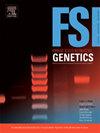Enhancing testing efficacy of high-density SNP microarrays to distinguish pedigrees belonging to the same kinship class
IF 3.2
2区 医学
Q2 GENETICS & HEREDITY
引用次数: 0
Abstract
Kinship testing, which involves genotyping genetic markers and comparing their profiles between individuals, holds significant applications in forensic science. However, the prevalent use of independent markers often lacks the discriminatory power to distinguish pedigrees belong to the same kinship class. While numerous studies have attempted to address this challenge through diverse approaches, the testing efficacy of high-density SNP microarrays in combination with the likelihood approach remains unclear.
In this study, we further explored the utilization of linked autosomal SNPs derived from microarrays with the likelihood approach. Several SNP panels with differing numbers of loci were developed and putative pedigrees were constructed to evaluated to test their efficacy in distinguishing second-degree relationships, including grandparent-grandchild, half-siblings, and avuncular. Our findings indicate that the use of high-density SNP microarrays is theoretically feasible for discriminating second-degree relationships, with balanced classification rates ranging from 0.444 to 0.853.
Moreover, to optimize the practical effectiveness of discriminating pedigrees belonging to the same kinship class, several other aspects such as adding additional SNPs or an additional relative and examining the effects of genotype errors and population selection were discussed. Our results revealed that the employment of denser marker sets with more accurate genotyping methods may be beneficial. Additionally, the inclusion of additional relatives and the selection of an appropriate reference population also appear to be crucial factors for enhancing the accuracy of kinship testing.
In conclusion, our study provides insights into the potential of high-density SNPs in kinship testing and highlights the need for further optimization and examination into various factors that may contribute to enhancing testing efficacy.
提高高密度 SNP 芯片的测试效率,以区分属于同一亲缘关系类别的血统
亲缘关系检验涉及对遗传标记进行基因分型并比较个体间的基因图谱,在法医学中具有重要的应用价值。然而,普遍使用的独立标记往往缺乏鉴别力,无法区分属于同一亲缘关系类别的血统。虽然许多研究都试图通过不同的方法来应对这一挑战,但高密度 SNP 微阵列与似然法相结合的测试功效仍不明确。在本研究中,我们进一步探讨了如何利用从微阵列中提取的常染色体 SNP 与似然法相结合。我们开发了几个具有不同基因位点数量的 SNP 面板,并构建了推定的血缘关系,以测试它们在区分二级关系(包括祖孙关系、同父异母关系和同母异父关系)方面的功效。我们的研究结果表明,使用高密度 SNP 微阵列来区分二级亲缘关系在理论上是可行的,其平衡分类率在 0.444 到 0.853 之间。此外,为了优化区分属于同一亲缘等级的血统的实际效果,我们还讨论了其他几个方面,如添加额外的 SNP 或额外的亲属,以及研究基因型误差和种群选择的影响。我们的研究结果表明,使用更密集的标记集和更精确的基因分型方法可能是有益的。总之,我们的研究深入揭示了高密度 SNP 在亲缘关系测试中的潜力,并强调了进一步优化和研究有助于提高测试效率的各种因素的必要性。
本文章由计算机程序翻译,如有差异,请以英文原文为准。
求助全文
约1分钟内获得全文
求助全文
来源期刊
CiteScore
7.50
自引率
32.30%
发文量
132
审稿时长
11.3 weeks
期刊介绍:
Forensic Science International: Genetics is the premier journal in the field of Forensic Genetics. This branch of Forensic Science can be defined as the application of genetics to human and non-human material (in the sense of a science with the purpose of studying inherited characteristics for the analysis of inter- and intra-specific variations in populations) for the resolution of legal conflicts.
The scope of the journal includes:
Forensic applications of human polymorphism.
Testing of paternity and other family relationships, immigration cases, typing of biological stains and tissues from criminal casework, identification of human remains by DNA testing methodologies.
Description of human polymorphisms of forensic interest, with special interest in DNA polymorphisms.
Autosomal DNA polymorphisms, mini- and microsatellites (or short tandem repeats, STRs), single nucleotide polymorphisms (SNPs), X and Y chromosome polymorphisms, mtDNA polymorphisms, and any other type of DNA variation with potential forensic applications.
Non-human DNA polymorphisms for crime scene investigation.
Population genetics of human polymorphisms of forensic interest.
Population data, especially from DNA polymorphisms of interest for the solution of forensic problems.
DNA typing methodologies and strategies.
Biostatistical methods in forensic genetics.
Evaluation of DNA evidence in forensic problems (such as paternity or immigration cases, criminal casework, identification), classical and new statistical approaches.
Standards in forensic genetics.
Recommendations of regulatory bodies concerning methods, markers, interpretation or strategies or proposals for procedural or technical standards.
Quality control.
Quality control and quality assurance strategies, proficiency testing for DNA typing methodologies.
Criminal DNA databases.
Technical, legal and statistical issues.
General ethical and legal issues related to forensic genetics.

 求助内容:
求助内容: 应助结果提醒方式:
应助结果提醒方式:


